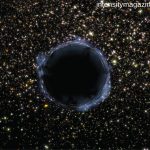In the rolling hills of Livermore, California, a colossal 10-story building dominates the landscape. Known as the National Ignition Facility (NIF), it spans an area equal to three football fields and houses one of the most ambitious scientific experiments in human history. Packed with lasers, mirrors, crystals, and exotic optical technology, this facility represents science’s relentless quest for a nearly limitless energy source: nuclear fusion.
Fusion, the same reaction that powers the sun, promises to deliver clean, safe, and virtually boundless energy. But the question remains — is this long-awaited energy miracle finally within reach, or is it still a scientific mirage?
Read More: Ancient Dark Black Holes: The Astonishing Key to Unlocking the Dark Matter Mystery in 2025
Inside the World’s Largest Laser Experiment
At the heart of NIF’s mission is an attempt to fuse hydrogen nuclei into helium without triggering a destructive thermonuclear explosion. Using the world’s most powerful laser system, 192 beams are combined and focused onto a BB-sized capsule of hydrogen fuel. The goal is to replicate, on a miniature scale, the same process that makes stars shine.
If successful, this controlled fusion could revolutionize energy production. Unlike traditional nuclear power, fusion would release no greenhouse gases, use no hazardous uranium fuel, and generate only short-lived radioactive waste. Most importantly, a fusion reaction cannot spiral into a meltdown. It ends naturally once its tiny fuel pellet is consumed.
The Elusive Dream of Ignition
For decades, scientists have pursued the holy grail of fusion: producing more energy from the reaction than the immense energy required to start it. Yet no laboratory has achieved this “net energy gain.”
Researchers at NIF, part of Lawrence Livermore National Laboratory, insist they are inching closer. Their method, called inertial confinement fusion, involves bombarding a gold cylinder (called a hohlraum) with intense laser bursts. This creates X-rays that compress the hydrogen fuel inside until nuclei collide and fuse, releasing energy.
The process is elegant in theory but extremely difficult in practice. Even micrometer-scale misalignments can derail a reaction. “We are not expecting it to work on the first try,” admits Jeff Latkowski, chief engineer of the Laser Inertial Fusion-Fission Engine (LIFE) program. Even in the best-case scenario, he adds, a commercial pilot plant remains at least a decade away.
Billions Spent, Critics Speak Out
Since construction began, the NIF project has cost U.S. taxpayers nearly $4 billion, far above original estimates. Annual operating costs run about $450 million. Critics argue that the Department of Energy rushed into building a giant facility without first mastering the underlying science.
Christopher Paine of the Natural Resources Defense Council is especially vocal:
“Livermore’s hype about a reactor in the near term is bizarre and irresponsible — the biggest failure in American experimental physics.”
Skeptics point to repeated delays, shifting timelines, and spiraling budgets as evidence that fusion always seems “a decade away.” Yet supporters argue the scientific challenges justify the costs, given the potential to transform global energy forever.
Global Race for Fusion Supremacy
Fusion research is not limited to the U.S. France, Japan, and especially China are pouring billions into their own programs. China’s rapid advances are striking. Just five years ago, its research lagged 20 years behind the NIF. Today, experts estimate the gap has narrowed to just a decade. With thousands of new plasma science PhDs graduating annually, China is emerging as a formidable competitor.
If NIF falters, the U.S. risks losing its leadership role in what could become the defining energy race of the century.
The Science of Creating a Star on Earth
Fusion may sound like science fiction, but its principles are well established. Albert Einstein’s famous equation E=mc² showed how small amounts of mass can convert into vast amounts of energy. In 1939, physicist Hans Bethe explained how fusion powers stars, earning him the Nobel Prize. Later, Cold War scientists like Andrei Sakharov explored ways to harness fusion through magnetic confinement.
Today, NIF relies on precision lasers to heat and compress hydrogen isotopes — deuterium and tritium — into helium. Each tiny fuel pellet, the size of a BB, could in theory release more energy than it takes to ignite. Oceans contain enough deuterium to power humanity’s energy needs for billions of years.
The main difference between a controlled fusion reaction and a nuclear explosion lies in containment. A hydrogen bomb uses a fission trigger to unleash uncontrolled fusion. In contrast, NIF’s experiments seek a safe, contained spark that produces energy — not destruction.
Technical Hurdles on the Road Ahead
Despite progress, challenges remain daunting. Lasers must fire not just a few times per day, but 10 to 15 times per second to support a working power plant. Current solid-state glass lasers cannot achieve this frequency.
Another challenge is scale. The NIF’s giant laser system stretches hundreds of feet, but future reactors will need smaller, more efficient machines. Advances in crystal growth, optics, and high-power lasers have helped, but much work lies ahead.
As Latkowski emphasizes:
“The NIF is not an efficient machine. It’s designed to demonstrate physics, not produce power.”
Beyond Fusion: The LIFE Project
Should ignition succeed, NIF scientists plan to pursue an even more ambitious project called LIFE (Laser Inertial Fusion Engine). This system would combine fusion ignition with a fission reaction, using existing nuclear waste as fuel. A LIFE reactor could, in theory, operate for 40 years without refueling, while reducing radioactive waste in the process.
Unlike the massive NIF setup, LIFE would rely on smaller, cheaper, modular laser systems suitable for factory production. Critics remain skeptical, arguing that current laser technology is still far from capable of supporting such a design.
A Future Worth Fighting For
Despite decades of setbacks, few doubt that controlled fusion is scientifically possible. Nobel Prize–winning physicist and former U.S. Energy Secretary Steven Chu has publicly expressed confidence in NIF’s efforts, declaring: “We’re going to assume ignition will be achieved.”
For the hundreds of scientists at Livermore, the project is more than a job — it’s the defining pursuit of their careers. Success would mean not just a scientific breakthrough, but a radical transformation of how the world generates energy. Failure, on the other hand, could relegate the U.S. to a supporting role in one of the greatest technological races in history.
Frequently Asked Questions:
What is nuclear fusion and why is it important?
Nuclear fusion is the process of combining two light atomic nuclei into one heavier nucleus, releasing massive energy. It’s important because it could provide a nearly limitless, clean, and safe power source for the world.
How does fusion differ from nuclear fission?
Fission splits heavy atoms like uranium, producing long-lived radioactive waste. Fusion merges light atoms like hydrogen, generating less hazardous waste and no risk of meltdown.
What is the National Ignition Facility (NIF)?
The NIF, located in Livermore, California, is the world’s largest laser-based research center dedicated to achieving controlled nuclear fusion.
Has NIF achieved net energy gain yet?
Not yet. Scientists have come close, but no experiment has produced more energy than the amount required to start the reaction.
Why is fusion called the “holy grail” of energy?
Fusion promises virtually unlimited power, zero greenhouse gas emissions, and abundant fuel from seawater, making it a potential game-changer for global energy needs.
What are the biggest challenges in fusion research?
Key obstacles include producing powerful enough lasers, maintaining precise alignment, achieving frequent firing rates, and building efficient reactors at scale.
Which countries are leading in the global fusion race?
The U.S., China, France, and Japan are investing heavily in fusion. China has made rapid progress and is emerging as a strong competitor.
Conclusion
Fusion energy stands at the crossroads of hope and skepticism. The National Ignition Facility represents humanity’s most determined attempt to unlock the same power that fuels the stars. Supporters see it as the ultimate clean-energy breakthrough, while critics view it as an overhyped and costly gamble. What’s clear is that the race is intensifying worldwide. If scientists succeed, fusion could deliver virtually limitless, safe, and sustainable power, reshaping global energy systems and addressing climate change. If they fail, billions will have been spent chasing a dream that remains just out of reach.



